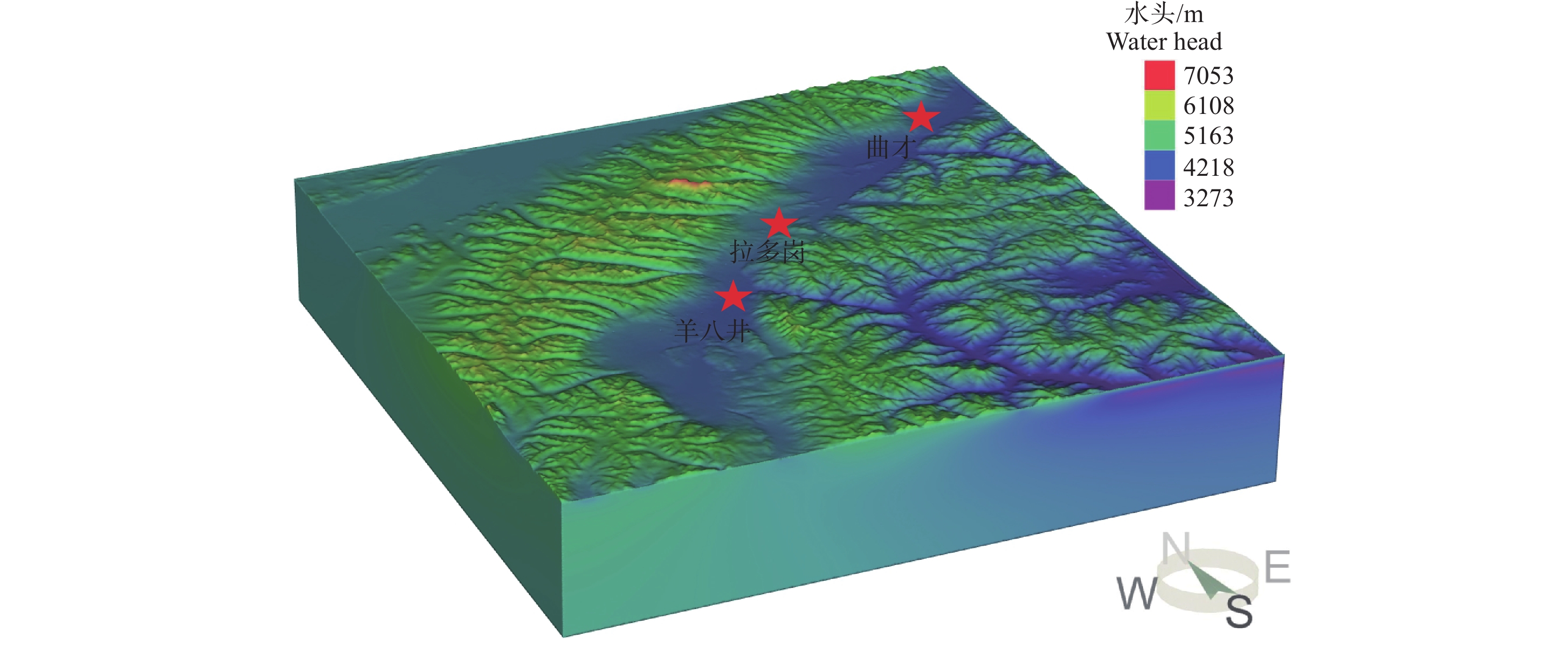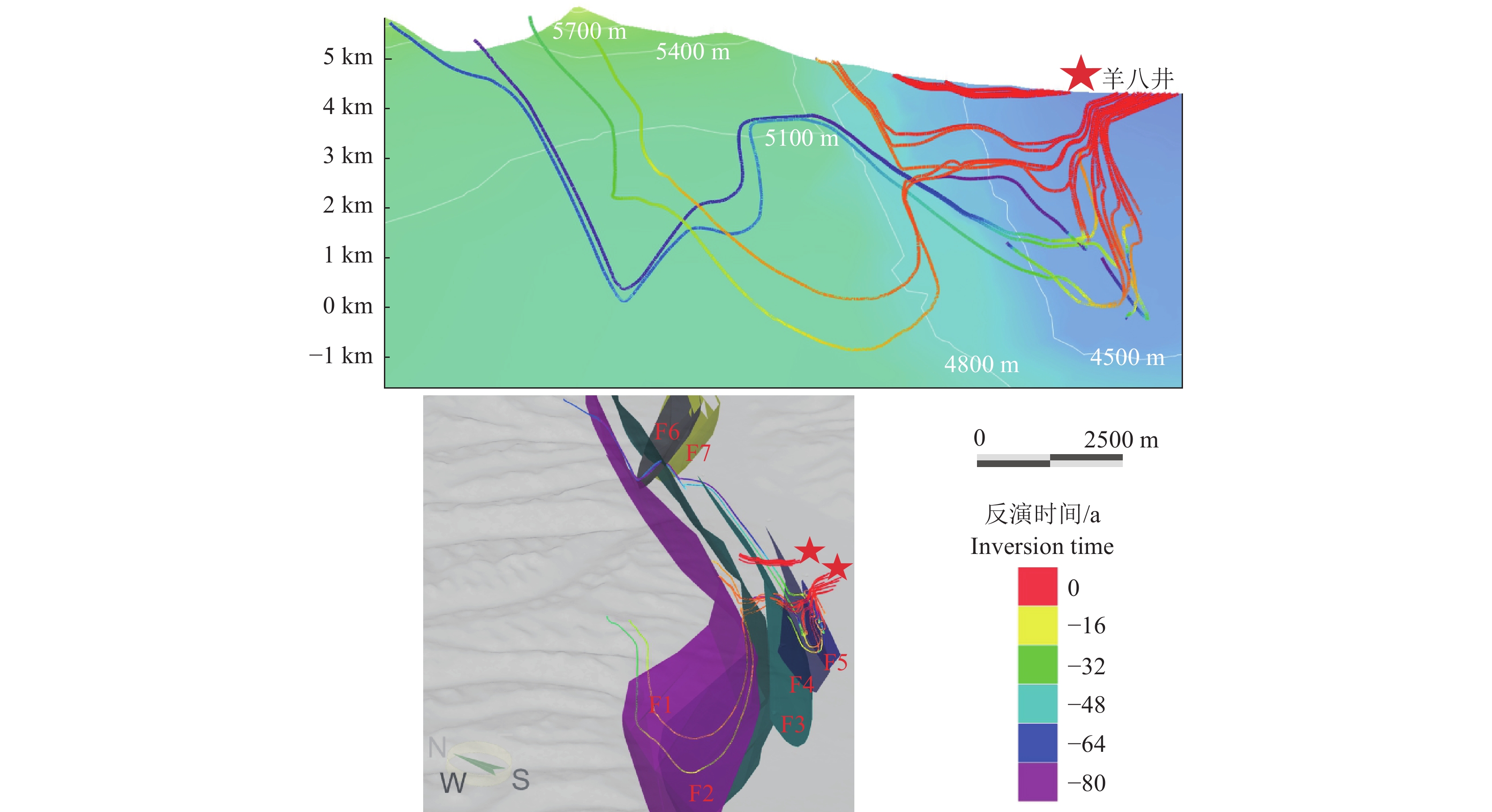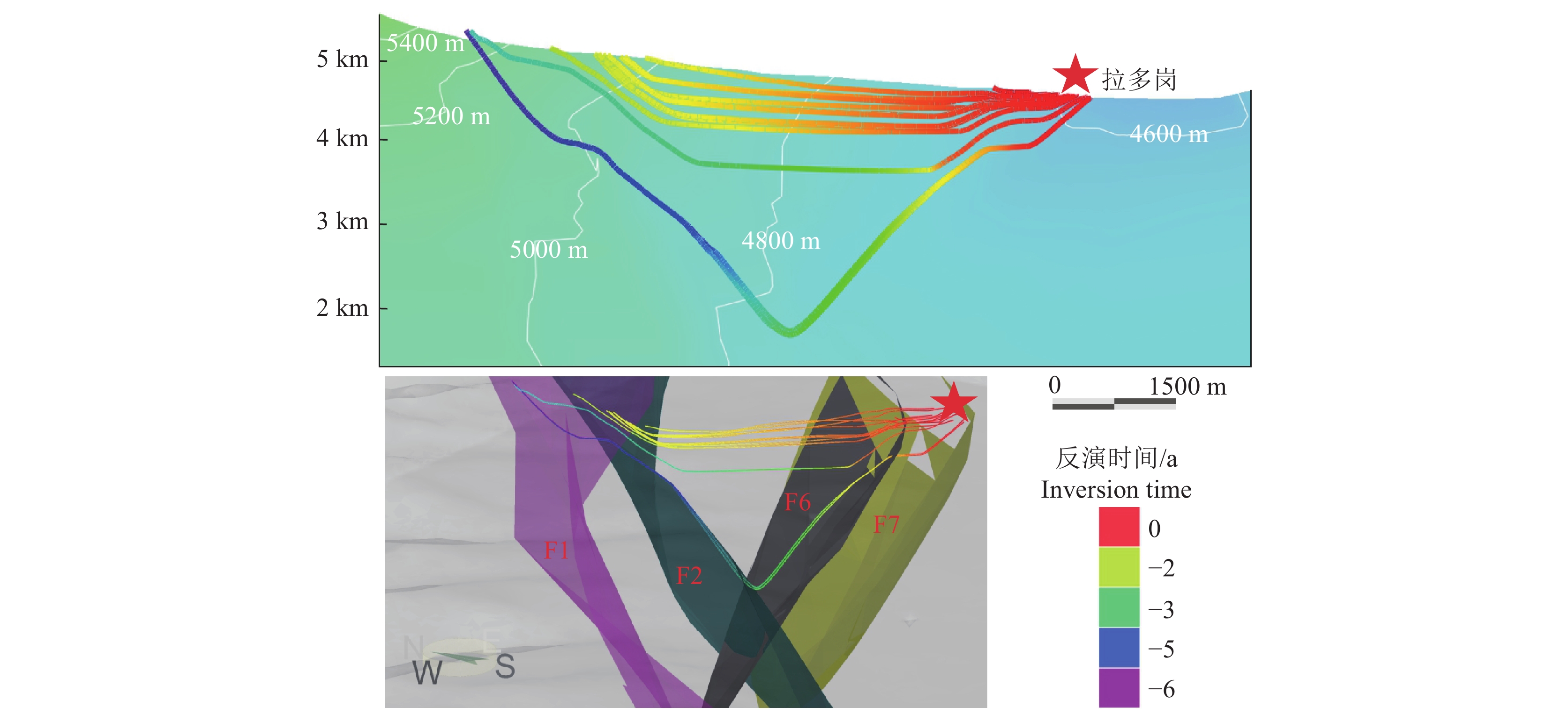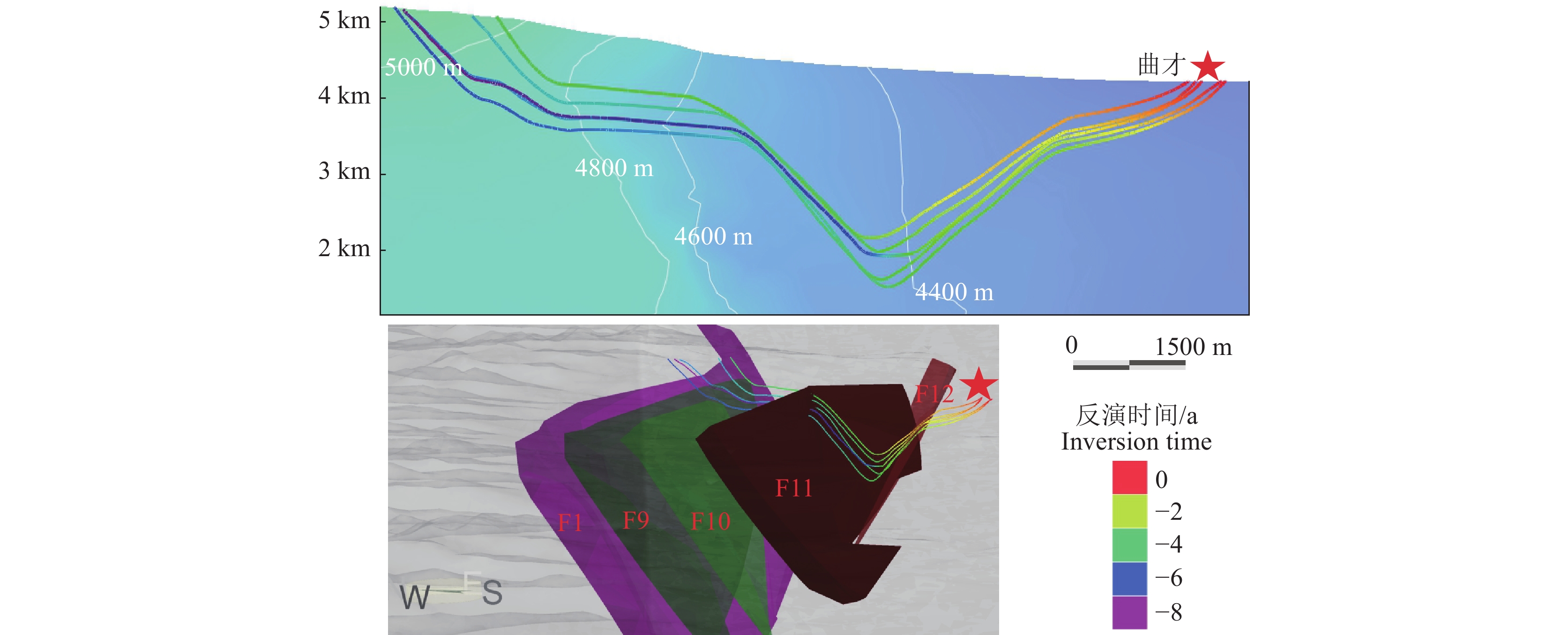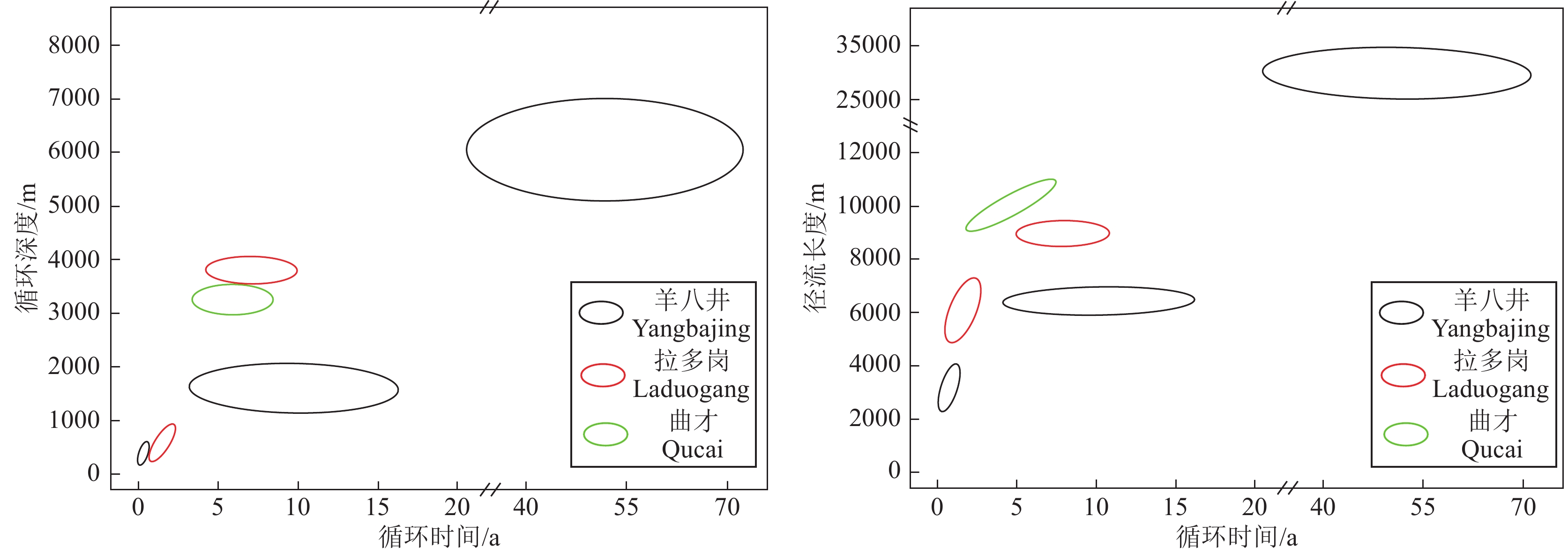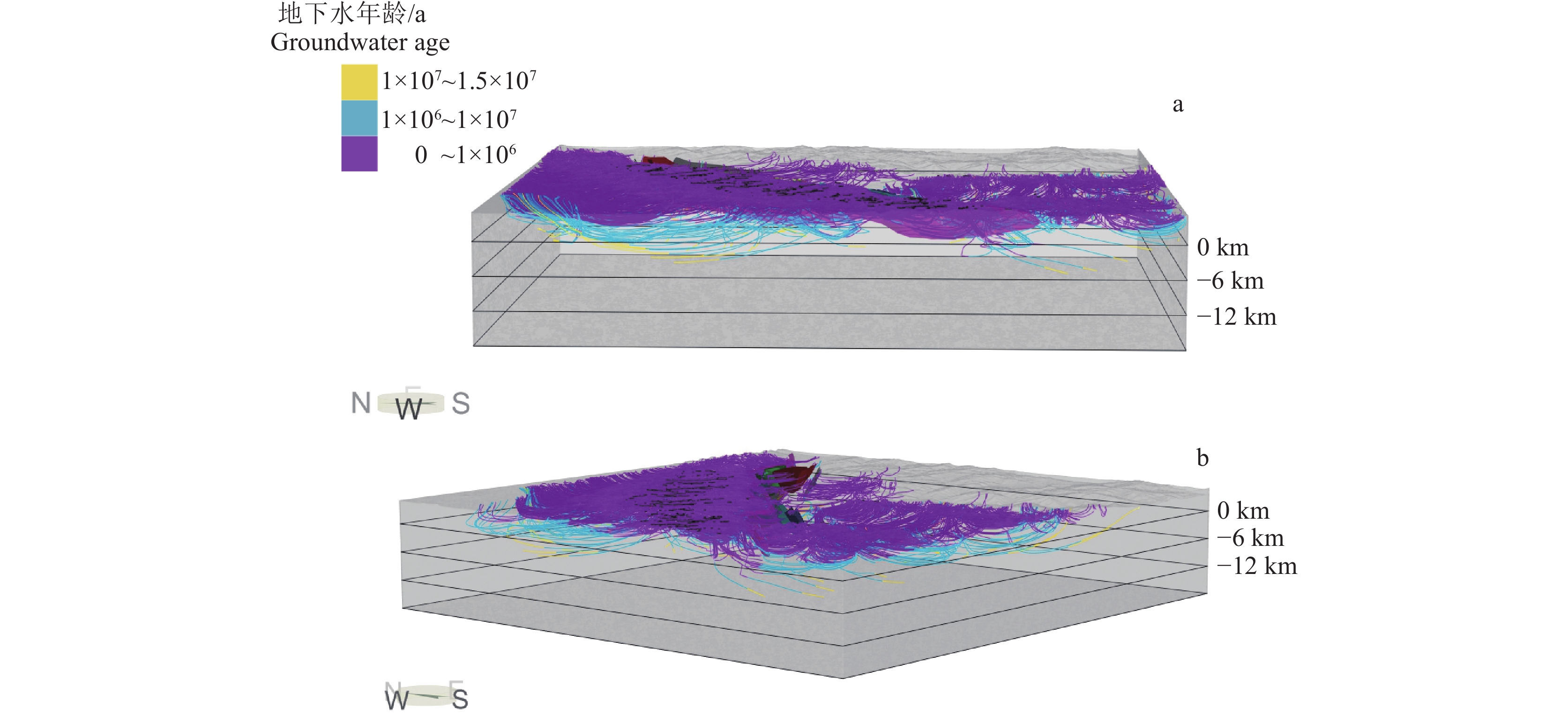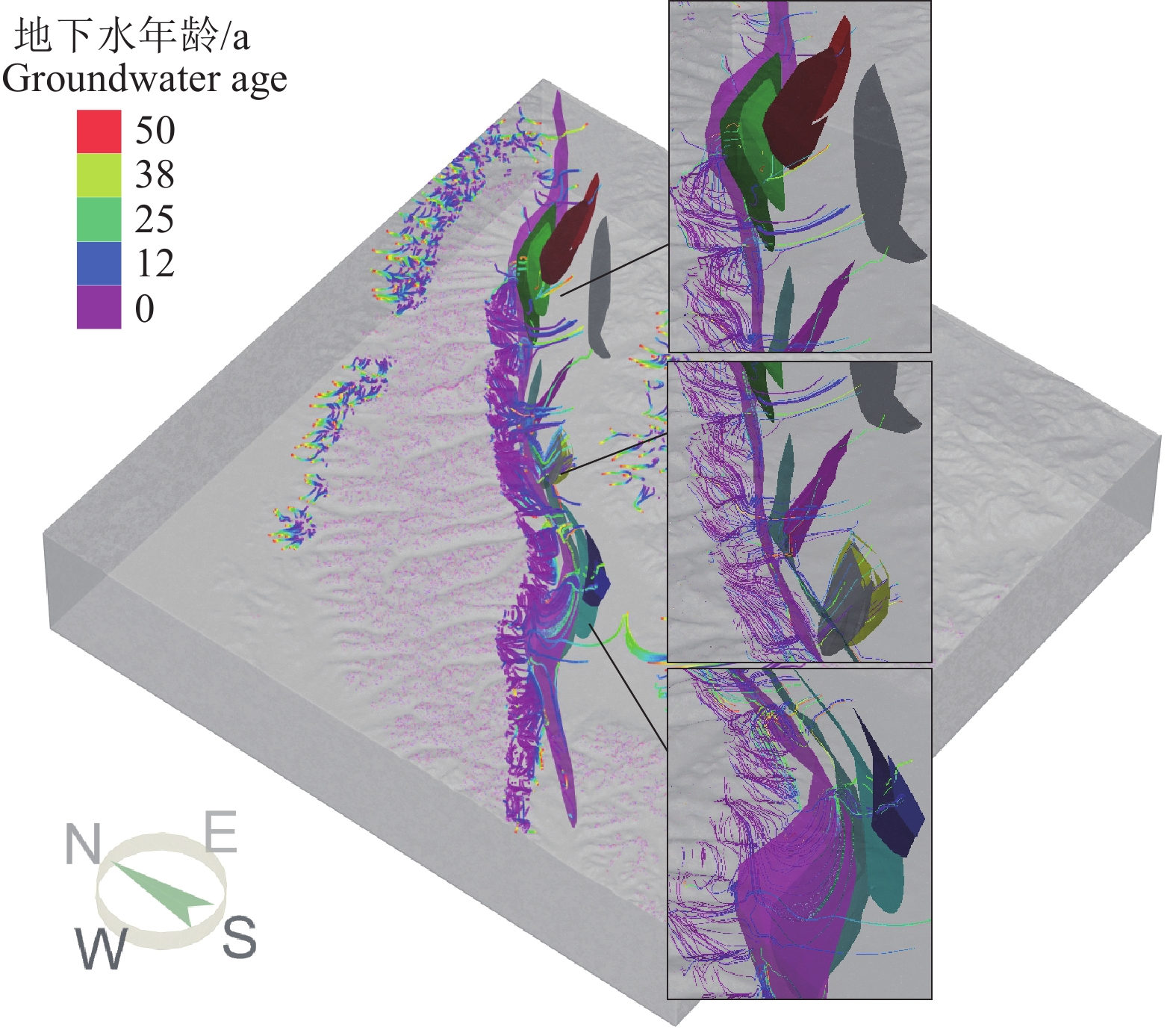Geothermal distribution and forming mechanism: Insight from 3D numerical simulation on Yangbajing−Ningzhong Basin, Xizang
-
摘要:
研究目的 高山区大气降水下渗至地下深部,经地下深循环排泄至地表,该过程涉及深部构造和水文地球化学,是形成丰富的地热和矿产资源的流体来源之一。前人使用水化学与同位素和数值模拟等方法研究探讨地下水源区和流动系统等,分析地下水循环深度、地下水循环时间和地下水运移机制,进而评估区域地热和矿产资源分布。
研究方法 结合西藏羊八井—宁中盆地DEM数据、断层和岩性等资料建立三维有限元几何模型,使用地下水模拟软件求解标准饱和地下水流动方程,探讨研究区典型热泉的循环系统和区域地下水运移规律。
研究结果 模拟结果表明,地下水在羊八井、拉多岗和曲才热泉的最大循环深度分别为5~7 km、3.5~4 km和3~3.6 km,相应的地下水循环时间为23~80年、5~6年和4~8年。念青唐古拉山地下水入渗深度达10 km,时间达百万年。
结论 各个热泉的地下水循环深度不同,循环补给时间也差异较大,它们之间的补给源区和循环路径存在较大差异,虽位于同一裂谷,但羊八井、拉多岗和曲才热泉彼此之间没有水力联系,造成物质组成的差异。
Abstract:This paper is the result of hydrogeological survey engineering.
Objective Meteoric water in the mountain areas infiltrates deep underground and circulates to the surface. It involves deep structural and hydrogeochemical processes, and it is one of the fluid source of forming rich geothermal and mineral resources. Predecessors focused on the groundwater source, circulation depth and flow system using methods of hydrochemistry isotope and numerical simulation, and further evaluated the distribution of regional geothermal and mineral resources.
Methods Based on the data of DEM, fault structure, and lithology of the Yangbajing−Ningzhong basin,we establish 3D geometry finite element model. The standard saturated groundwater flow equation is solved using groundwater simulation software, and we analyse the circulation system of the typical hot springsand regional groundwater migration.
Results The simulation results show that the maximum circulation depths of groundwater are respectively 5−7 km, 3.5−4 km, and 3−3.6 km at Yangbajing, Laduogang, and Qucai springs, and the corresponding groundwater circulation times are 23−80, 5−6 and 4−8 years. The groundwater of Nyainqentanglha Mountain seeps down to 10 km depth, where the time spans million years.
Conclusions In general, the circulation depth and the recharge time of hot springs are different due to their different supply sources and circulation paths. Notably, there is no hydraulic connection between the hot springs at Yangbajing, Laduogang, and Qucai, although they are located in the same rift valley. It results in differences in material composition among these springs.
-

-
图 1 喜马拉雅—西藏造山带区域构造图(a,底图据Liu et al., 2021)和研究区区域地质图(b,c)
Figure 1.
表 1 模型内各岩性单元水平渗透系数
Table 1. Horizontal permeability coefficient of each lithology unit in the model.
岩性单元 水平渗透系数/(m/s) 数据来源 花岗岩 1×10−8~1×10−10 Mejías et al., 2009;
Stober and Bucher, 2015第四系沉积物 5.5×10−4 Yao et al., 2021 糜棱岩 5.3×10−4 Fan, 2002 灰岩砂岩 1.7×10−5 Yao et al., 2017 断层 1×10−3 Ge et al., 2008 -
[1] Alsdorf D, Brown L, Nelson K D, Makovsky Y, Klemperer S, Zhao W J. 1998. Crustal deformation of the Lhasa terrane, Xizang plateau from Project INDEPTH deep seismic reflection profiles[J]. Tectonics, 17(4): 501−519.
[2] Armijo R, Tapponnier P, Mercier J L, Han T L. 1986. Quaternary extension in southern Xizang: Field observations and tectonic implications[J]. Journal of Geophysical Research: Solid Earth, 91(B14): 13803−13872. doi: 10.1029/JB091iB14p13803
[3] Bossong C R. 2003. Hydrologic Conditions and Assessment of Water Resources in the Turkey Creek Watershed, Jefferson County, Colorado, 1998–2001[M]. US Department of the Interior, US Geological Survey.
[4] Brown L D, Zhao W J, Nelson K D, Hauck M, Alsdorf D, Ross A, Cogan M, Clark M, Liu X W, Che J K. 1996. Bright spots, structure, and magmatism in southern Xizang from INDEPTH seismic reflection profiling[J]. Science, 274(5293): 1688−1690.
[5] Butler R W H, Harris N B W, Whittington A G. 1997. Interactions between deformation, magmatism and hydrothermal activity during active crustal thickening: A field example from Nanga Parbat, Pakistan Himalayas[J]. Mineralogical Magazine, 61(404): 37−52. doi: 10.1180/minmag.1997.061.404.05
[6] Caine J S, Manning A H, Verplanck P L, Bove D J. 2006. Well construction information, lithologic logs, water level data, and overview of research in Handcart Gulch, Colorado: An alpine watershed affected by metalliferous hydrothermal alteration[J]. Open–File Report. U. S. Geological Survey.
[7] Cathles L M, Erendi A H J, Barrie T. 1997. How long can a hydrothermal system be sustained by a single intrusive event?[J]. Economic Geology, 92(7/8): 766−771.
[8] Chen J C, Kuang X X, Lancia M, Yao Y Y, Zheng C M. 2021. Analysis of the groundwater flow system in a high–altitude headwater region under rapid climate warming: Lhasa River Basin, Xizang Plateau[J]. Journal of Hydrology: Regional Studies, 36: 100871. doi: 10.1016/j.ejrh.2021.100871
[9] Craw D, Koons P O, Zeitler P K, KIDD W S F. 2005. Fluid evolution and thermal structure in the rapidly exhuming gneiss complex of Namche Barwa–Gyala Peri, eastern Himalayan syntaxis[J]. Journal of Metamorphic Geology, 23(9): 829−845. doi: 10.1111/j.1525-1314.2005.00612.x
[10] Diamond L W, Wanner C, Waber H N. 2018. Penetration depth of meteoric water in orogenic geothermal systems[J]. Geology, 46(12): 1063−1066. doi: 10.1130/G45394.1
[11] Duo J, Zhao P. 2000. Characteristics and genesis of the Yangbajing geothermal field, Xizang[C]//Proceedings of the world geothermal congress, Kyushu–Tohoku, Japan. 28.
[12] Duo Ji. 2003. The basic characteristics of the Yangbajing geothermal field–A typical high temperature geothermal system[J]. Strategic Study of CAE, 5(1): 42−47 (in Chinese with English abstract).
[13] Fan X P. 2002. Conceptual Model and Assessment of the Yangbajing Geothermal Field, Xizang, China[M]. United Nations University.
[14] Feng Z J, Zhao Y S, Zhou A C, Zhang N. 2012. Development program of hot dry rock geothermal resource in the Yangbajing Basin of China[J]. Renewable Energy, 39(1): 490−495. doi: 10.1016/j.renene.2011.09.005
[15] Ge S M, Wu Q B, Lu N, Jiang G L, Ball L. 2008. Groundwater in the Xizang Plateau, western China[J]. Geophysical Research Letters, 35(18): 18403−1−5.
[16] Grasby S E, Hutcheon I. 2001. Controls on the distribution of thermal springs in the southern Canadian Cordillera[J]. Canadian Journal of Earth Sciences, 38(3): 427−440. doi: 10.1139/e00-091
[17] Guo Q H, Wang Y X, Liu W. 2007. Major hydrogeochemical processes in the two reservoirs of the Yangbajing geothermal field, Xizang, China[J]. Journal of Volcanology and Geothermal Research, 166(3/4): 255−268.
[18] Guo Q H. 2012. Hydrogeochemistry of high–temperature geothermal systems in China: A review[J]. Applied Geochemistry, 27(10): 1887−1898. doi: 10.1016/j.apgeochem.2012.07.006
[19] Hochstein M P, Regenauer–Lieb K. 1998. Heat generation associated with collision of two plates: The Himalayan geothermal belt[J]. Journal of Volcanology and Geothermal Research, 83(1/2): 75−92.
[20] Kapp P, Taylor M, Stockli D, Ding L. 2008. Development of active low–angle normal fault systems during orogenic collapse: Insight from Xizang[J]. Geology, 36(1): 7−10. doi: 10.1130/G24054A.1
[21] Li Zhengqing, Hou Zengqian, Nie Fengjun, Meng Xiangjin. 2005. Characteristic and distribution of the partial melting layers in the upper crust: Evidence from active hydrothermal fluid in the South Xizang[J]. Acta Geologica Sinica, 79(1): 68−77 (in Chinese with English abstract).
[22] Liu Mingliang. 2018. Boron Geochemistry of the Geothermal Waters From Typical Hydrothermal Systems in Xizang[D]. Wuhan: China University of Geosciences, 1–129 (in Chinese with English abstract).
[23] Liu Z C, Wang J G, Liu X C, Liu Y D, Lai Q Z. 2021. Middle Miocene ultrapotassic magmatism in the Himalaya: A response to mantle unrooting process beneath the orogen[J]. Terra Nova, 33(3): 240−251. doi: 10.1111/ter.12507
[24] Liu Zhao, Lin Wenjing, Zhang Meng, Xie Ejun, Liu Zhiming, Wang Guiling. 2014. Geothermal fluid genesis and mantle fluids contributions in Nimu–Naqu, Xizang[J]. Earth Science Frontiers, 21(60): 356−371 (in Chinese with English abstract).
[25] Lu Yi, Su Jinbao, Tan Hongbing, Xu Peng, Chen Zhenkun. 2019. Geochemical characteristics and origin of sinters in the southeastern margin of Xizang[J]. Bulletin of Mineralogy, Petrology and Geochemistry, 38(6): 1207–1223 (in Chinese with English abstract).
[26] Marazuela M A, Ayora C, Vázquez–Suñé E, Olivella S, García–Gil A. 2020. Hydrogeological constraints for the genesis of the extreme lithium enrichment in the Salar de Atacama (NE Chile): A thermohaline flow modelling approach[J]. Science of the Total Environment, 739: 139959. doi: 10.1016/j.scitotenv.2020.139959
[27] Mejías M, Renard P, Glenz D. 2009. Hydraulic testing of low–permeability formations: A case study in the granite of Cadalso de los Vidrios, Spain[J]. Engineering Geology, 107(3/4): 88−97.
[28] Menzies C D, Teagle D A H, Craw D, Cox S C, Boyce A J, Barrie C D, Roberts S. 2014. Incursion of meteoric waters into the ductile regime in an active orogen[J]. Earth and Planetary Science Letters, 399: 1−13. doi: 10.1016/j.jpgl.2014.04.046
[29] Nesbitt B E, Muehlenbachs K, Murowchick J B. 1989. Genetic implications of stable isotope characteristics of mesothermal Au deposits and related Sb and Hg deposits in the Canadian Cordillera[J]. Economic Geology, 84(6): 1489−1506. doi: 10.2113/gsecongeo.84.6.1489
[30] Ren Shaoting, Menenti M, Li J, Zhang J, Zhang J X, Li X. 2020. Glacier mass balance in the Nyainqentanglha Mountains between 2000 and 2017 retrieved from ZiYuan–3 stereo images and the SRTM DEM[J]. Remote Sensing, 12(5): 864. doi: 10.3390/rs12050864
[31] Shao Zhaogang. 2005. Analysis of the Cenozoic Hydrothermal Metallotectonic System and Evaluation of Ore Resoures in the Yangbajain–Lhunzhunb Region, Xizang[D]. Beijing: Chinese Academy of Geological Sciences, 1–155 (in Chinese with English abstract).
[32] Stober I, Bucher K. 2015. Hydraulic conductivity of fractured upper crust: Insights from hydraulic tests in boreholes and fluid–rock interaction in crystalline basement rocks[J]. Geofiuids, 15(1/2): 161−178.
[33] Stober I, Zhong J S, Zhang L F, Bucher K. 2016. Deep hydrothermal fluid–rock interaction: The thermal springs of Da Qaidam, China[J]. Geofluids, 16(4): 711−728.
[34] Su J B, Tan H B, Chen X. 2020. The groundwater deep circulation and large–scale geothermal deposition in response to the extension of the Yadong–Gulu rift, South Xizang, China[J]. Journal of Volcanology and Geothermal Research, 395: 106836. doi: 10.1016/j.jvolgeores.2020.106836
[35] Su J B, Tan H B. 2022. The genesis of rare–alkali metal enrichment in the geothermal anomalies controlled by faults and magma along the northern Yadong–Gulu rift[J]. Ore Geology Reviews, 147: 104987. doi: 10.1016/j.oregeorev.2022.104987
[36] Taillefer A, Guillou–Frottier L, Soliva R, Magri F, Lopez S, Courrioux G, Millot R, Ladouche B, Goff E L. 2018. Topographic and faults control of hydrothermal circulation along dormant faults in an orogen[J]. Geochemistry, Geophysics, Geosystems, 19(12): 4972–4995.
[37] Tan H B, Zhang Y F, Zhang W J, Kong N, Zhang Q, Huang J Z. 2014. Understanding the circulation of geothermal waters in the Xizang Plateau using oxygen and hydrogen stable isotopes[J]. Applied Geochemistry, 51: 23−32. doi: 10.1016/j.apgeochem.2014.09.006
[38] Tapponnier P, Mercier J L, Armijo R, Han T L, Zhou J. 1981. Field evidence for active normal faulting in Xizang[J]. Nature, 294(5840): 410−414. doi: 10.1038/294410a0
[39] Tian X B, Chen Y, Tseng T L, Klemperer S L, Thybo Hans, Liu Z, Xu T, Liang X F, Bai Z M, Zhang X, Si S K, Sun C Q, Lan H Q, Wang E C, Teng J W. 2015. Weakly coupled lithospheric extension in southern Xizang[J]. Earth and Planetary Science Letters, 430: 171−177.
[40] Tiedeman C R, Goode D J, Hsieh P A. 1998. Characterizing a ground water basin in a New England mountain and valley terrain[J]. Groundwater, 36(4): 611−620. doi: 10.1111/j.1745-6584.1998.tb02835.x
[41] Tong Wei. 2000. Thermal Springs in Xizang[M]. Beijing: Science Press (in Chinese).
[42] Wang Z, Wang J, Yang X Q. 2021. The role of fluids in the 2008 Ms8.0 Wenchuan earthquake, China[J]. Journal of Geophysical Research: Solid Earth, 126(2): e2020JB019959. doi: 10.1029/2020JB019959
[43] Wanner C, Waber H N, Bucher K. 2020. Geochemical evidence for regional and long–term topography–driven groundwater flow in an orogenic crystalline basement (Aar Massif, Switzerland)[J]. Journal of hydrology, 581: 124374. doi: 10.1016/j.jhydrol.2019.124374
[44] Wei Keqin, Lin Ruifen, Wang Zhixiang. 1983. Hydrogen and oxygen stable isotopic composition and tritium content of waters from Yangbajain geothermal area, Xizang, China[J]. Geochimica, (4): 338−346 (in Chinese with English abstract).
[45] Wickham S M, Peters M T, Fricke H C, O'Neil J R. 1993. Identification of magmatic and meteoric fluid sources and upward–and downward–moving infiltration fronts in a metamorphic core complex[J]. Geology, 21(1): 81−84. doi: 10.1130/0091-7613(1993)021<0081:IOMAMF>2.3.CO;2
[46] Wu Zhenhan, Hu Daogong, Liu Qisheng, Ye Peisheng, Wu Zhonghai. 2005. Chronological analyses of the thermal evolution of granite and the uplift process of the Nyainqentanglha range in Central Xizang[J]. Acta Geoscientica Sinica, 26(6): 505−512 (in Chinese with English abstract).
[47] Wu Zhonghai, Ye Peisheng, Wang Chengmin, Zhang Keqi, Zhao Hua, Zheng Yonggang, Yin Jinhui, Li Huhou. 2015. The relics, ages and significance of prehistoric large earthquakes in the Angang Graben in South Xizang[J]. Earth Science, 40(10): 1621−1642 (in Chinese with English abstract).
[48] Yao Y Y, Zheng C M, Andrews C B, Scanlon B R, Kuang X X, Zeng Z Z, Jeong S J, Lancia M, Wu Y P, Li G S. 2021. Role of groundwater in sustaining Northern Himalayan Rivers[J]. Geophysical Research Letters, 48(10): e2020GL092354.
[49] Yao Y Y, Zheng C M, Andrews C B, Zheng Y, Zhang A J, Liu J. 2017. What controls the partitioning between baseflow and mountain block recharge in the Qinghai−Xizang Plateau?[J]. Geophysical Research Letters, 44(16): 8352−8358. doi: 10.1002/2017GL074344
[50] Yokoyama T, Nakai S, Wakita H. 1999. Helium and carbon isotopic compositions of hot spring gases in the Xizang Plateau[J]. Journal of Volcanology And Geothermal Research, 88(1/2): 99−107. doi: 10.1016/S0377-0273(98)00108-5
[51] Yong B, Wang C Y, Chen J S, Chen J Q, Barry D A, Wang T, Li L. 2021. Missing water from the Qiangtang Basin on the Xizang Plateau[J]. Geology, 49(7): 867−872.
[52] Zeng Y C, Tang L S, Wu N Y, Cao Y F. 2018. Numerical simulation of electricity generation potential from fractured granite reservoir using the MINC method at the Yangbajing geothermal field[J]. Geothermics, 75: 122−136.
[53] Zeng Y C, Wu N Y, Su Z, Hu J. 2014. Numerical simulation of electricity generation potential from fractured granite reservoir through a single horizontal well at Yangbajing geothermal field[J]. Energy, 65: 472−487. doi: 10.1016/j.energy.2013.10.084
[54] Zhang W J, Tan H B, Zhang Y F, Wei H Z, Dong T. 2015. Boron geochemistry from some typical Xizang hydrothermal systems: Origin and isotopic fractionation[J]. Applied Geochemistry, 63: 436−445. doi: 10.1016/j.apgeochem.2015.10.006
[55] Zhang Xigen. 1998. Sulfur mineralization of modern geothermal system in Yangbajing basin of Xizang[J]. Geology of Chemical Minerals, 20(1): 1−10 (in Chinese with English abstract).
[56] Zhang Z J, Chen Y, Yuan X H, Tian X B, Klemperer S L, Xu T, Bai Z M, Zhang H S, Wu J, Teng J W. 2013. Normal faulting from simple shear rifting in South Xizang, using evidence from passive seismic profiling across the Yadong–Gulu Rift[J]. Tectonophysics, 606: 178−186. doi: 10.1016/j.tecto.2013.03.019
[57] Zhao Ping, Duo Ji, Xie Ejun, Jin Jian. 2003. Strontium isotope data for thermal waters in selected high–temperature geothermal fields, China[J]. Acta Petrologica Sinica, 19(30): 569−576 (in Chinese with English abstract).
[58] Zhao Ping, Jin Jian, Zhang Haizheng, Duo Ji, Liang Tingli. 1998. Chemical composition of thermal water in the Yangbajing geothermal field, Xizang[J]. Chinese Journal of Geology, 33(1): 61–72 (in Chinese with English
[59] Zhao Ping, Kennedy M, Duo Ji, Xie Ejun, Du Shaoping, Shuster D, Jin Jian. 2001. Noble gases constraints on the origin and evolution of geothermal fluids from the Yangbajain geothermal field, Xizang[J]. Acta Petrologica Sinica, 17(3): 497−503 (in Chinese with English abstract).
[60] Zhao Ping, Xie Ejun, Duo Ji, Jin Jian, Hu Xiancai, Du Shaoping, Yao Zhonghua. 2002. Geochemical charact eristics of geothermal gases and their geological implications in Xizang[J]. Acta Petrologica Sinica, 18(4): 539−550 (in Chinese with English abstract).
[61] Zhou Li. 2012. Characteristics of the Typical Hot Springs in the Central Xizang[D]. Beijing: China University of Geosciences, 1–79 (in Chinese with English abstract).
[62] Zuo J M, Wu Z H, Ha G H, Hu M M, Zhou C J, Gai H L. 2021. Spatial variation of nearly NS–trending normal faulting in the southern Yadong–Gulu rift, Xizang: New constraints from the Chongba Yumtso fault, Duoqing Co graben[J]. Journal of Structural Geology, 144: 104256. doi: 10.1016/j.jsg.2020.104256
[63] 多吉. 2003. 典型高温地热系统—羊八井热田基本特征[J]. 中国工程科学, 5(1): 42−47. doi: 10.3969/j.issn.1009-1742.2003.01.008
[64] 李振清, 侯增谦, 聂凤军, 孟祥军. 2005. 藏南上地壳低速高导层的性质与分布: 来自热水流体活动的证据[J]. 地质学报, 79(1): 68−77. doi: 10.3321/j.issn:0001-5717.2005.01.008
[65] 刘明亮. 2018. 西藏典型高温水热系统中硼的地球化学研究[D]. 武汉: 中国地质大学 (武汉), 1–129.
[66] 刘昭, 蔺文静, 张萌, 谢鄂军, 刘志明, 王贵玲. 2014. 西藏尼木—那曲地热流体成因及幔源流体贡献[J]. 地学前缘, 21(6): 356−371.
[67] 陆艺, 苏金宝, 谭红兵, 徐鹏, 陈振坤. 2019. 西藏东南缘地热泉华的地球化学特征和成因[J]. 矿物岩石地球化学通报, 38(6): 1207−1223.
[68] 邵兆刚. 2005. 西藏羊八井—林周地区新生代水热成矿构造系统分析及资源评价[D]. 北京: 中国地质科学院, 1–155.
[69] 佟伟. 2000. 西藏温泉志[M]. 北京: 科学出版社.
[70] 卫克勤, 林瑞芬, 王志祥. 1983. 西藏羊八井地热水的氢, 氧稳定同位素组成及氚含量[J]. 地球化学, (4): 338−346. doi: 10.3321/j.issn:0379-1726.1983.04.002
[71] 吴珍汉, 胡道功, 刘琦胜, 叶培盛, 吴中海. 2005. 念青唐古拉花岗岩热演化历史和山脉隆升过程的热年代学分析[J]. 地球学报, 26(6): 505−512. doi: 10.3321/j.issn:1006-3021.2005.06.004
[72] 吴中海, 叶培盛, 王成敏, 张克旗, 赵华, 郑勇刚, 尹金辉, 李虎侯. 2015. 藏南安岗地堑的史前大地震遗迹、年龄及其地质意义[J]. 地球科学, 40(10): 1621−1642.
[73] 张锡根. 1998. 西藏羊八井现代地下热水系统硫矿的成矿作用[J]. 化工矿产地质, 20(1): 1−10.
[74] 赵平, 金建, 张海政, 多吉, 梁廷立. 1998. 西藏羊八井地热田热水的化学组成[J]. 地质科学, 33(1): 61–72.
[75] 赵平, Mack KENNEDY, 多吉, 谢鄂军, 杜少平, David SHUSTER, 金建. 2001. 西藏羊八井热田地热流体成因及演化的惰性气体制约[J]. 岩石学报, 17(3): 497−503. doi: 10.3321/j.issn:1000-0569.2001.03.020
[76] 赵平, 谢鄂军, 多吉, 金建, 胡先才, 杜少平, 姚中华. 2002. 西藏地热气体的地球化学特征及其地质意义[J]. 岩石学报, 18(4): 539−550. doi: 10.3969/j.issn.1000-0569.2002.04.013
[77] 赵平, 多吉, 谢鄂军, 金建. 2003. 中国典型高温热田热水的锶同位素研究[J]. 岩石学报, 19(3): 569−576. doi: 10.3969/j.issn.1000-0569.2003.03.023
[78] 周立. 2012. 西藏中部典型温泉特征[D]. 北京: 中国地质大学 (北京), 1–79.
-



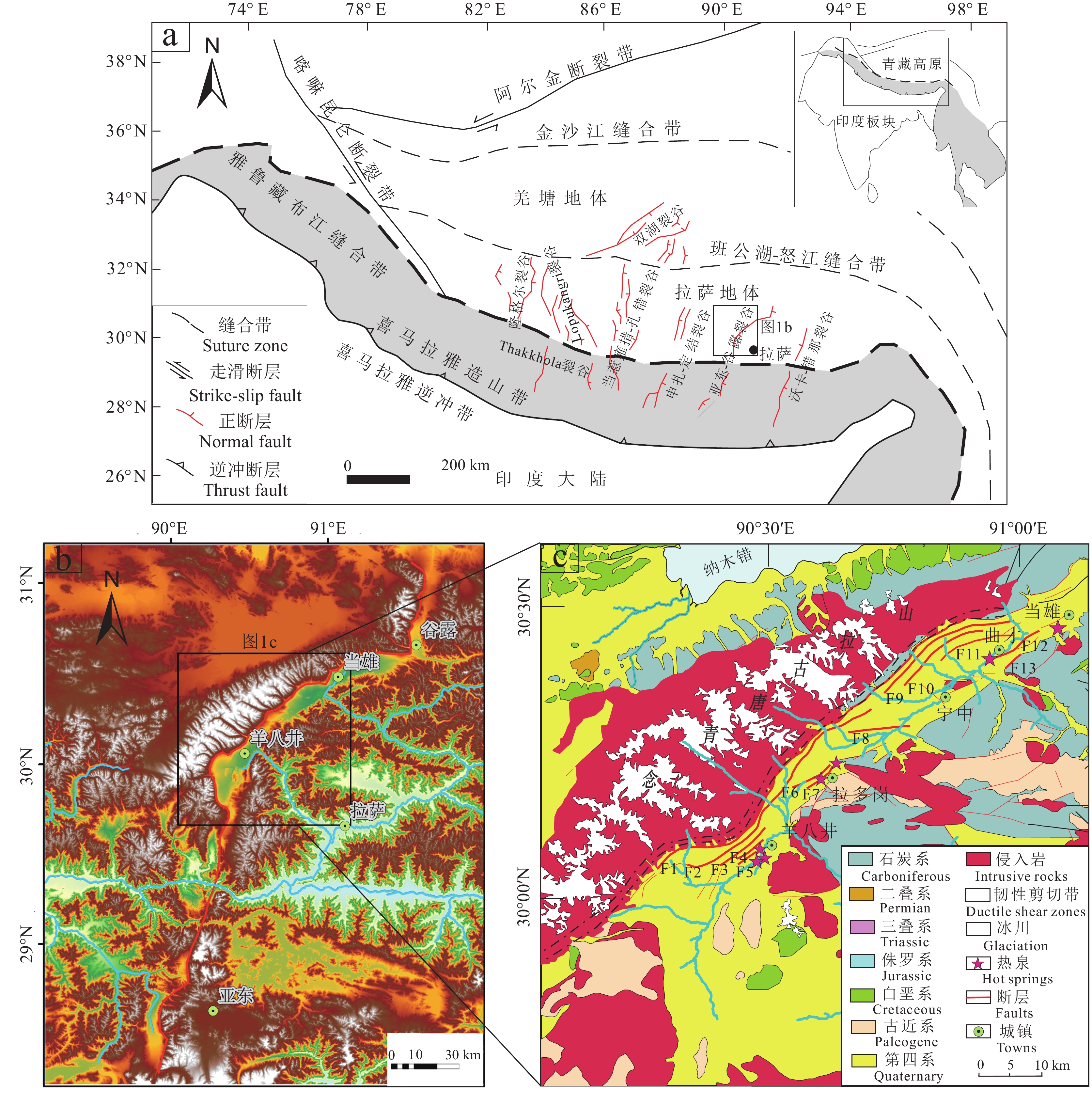
 下载:
下载:

